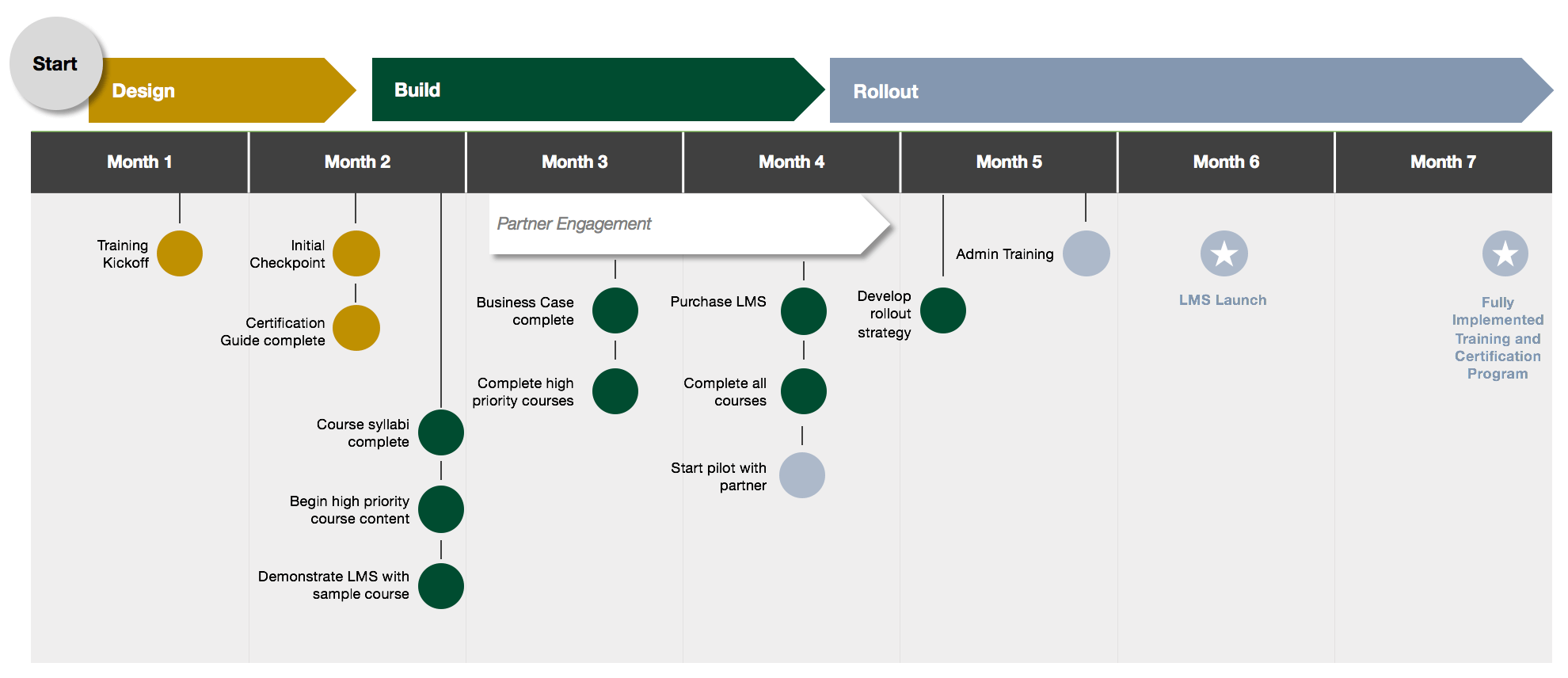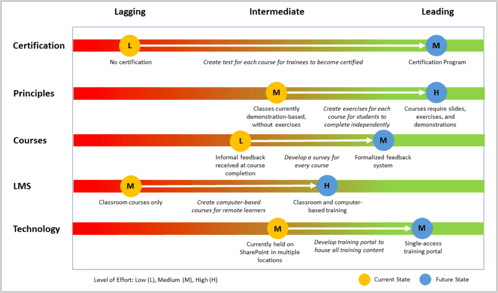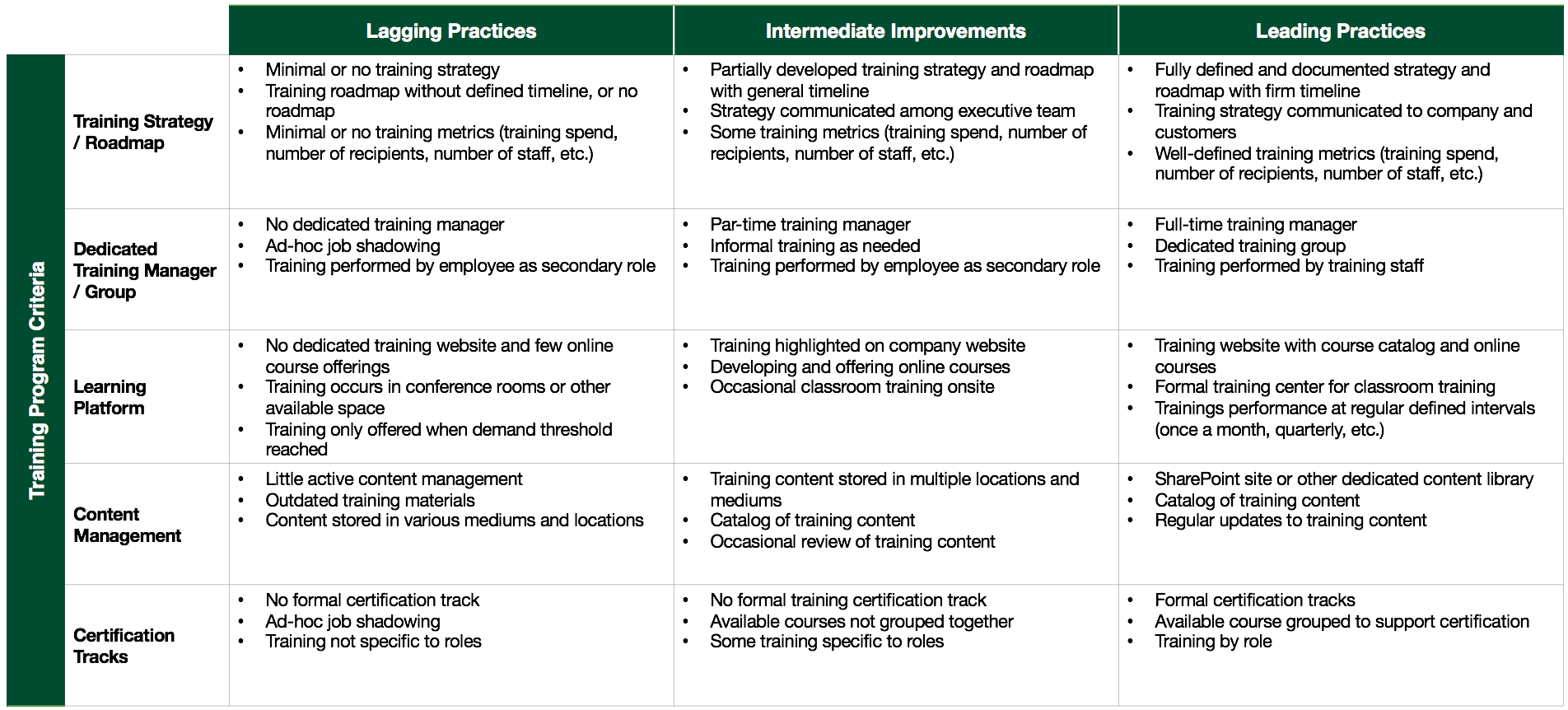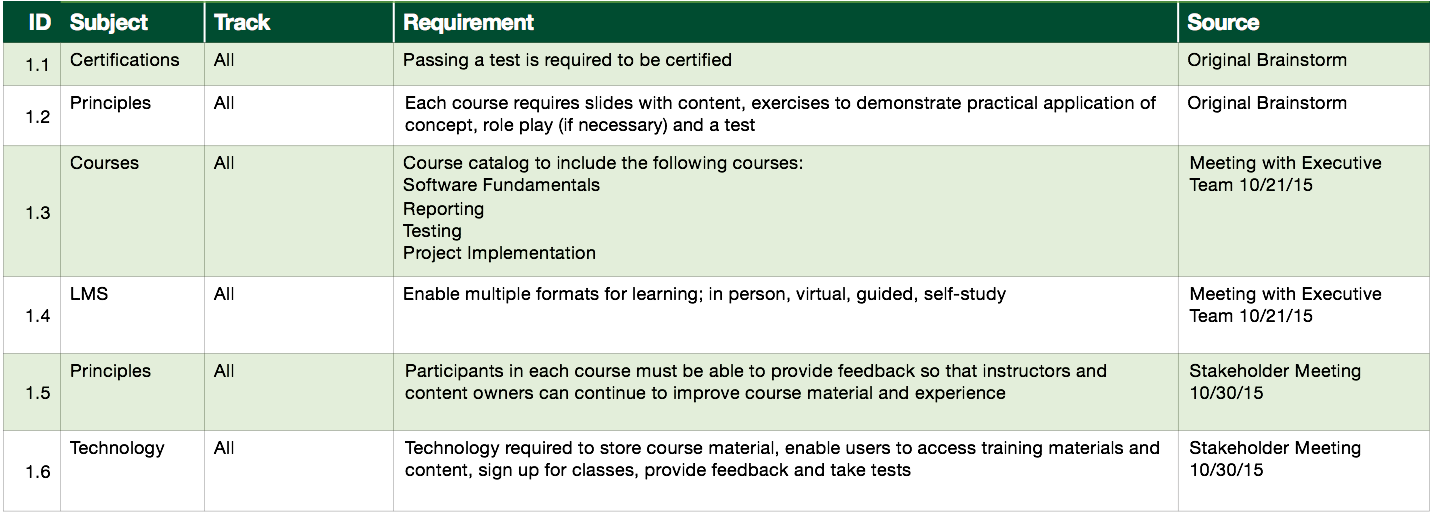Banner Section
Strategic Importance of Building an Enterprise Training Program
Points of View - Inner
Strategic Importance of Building an Enterprise Training Program

For an enterprise software company, training employees, partners, and customers has become a competitive advantage in the success of its market presence and its long term growth and viability. Prosperity in the highly competitive enterprise software industry relies on a company’s ability to foster and grow a robust network of user communities, and service and channel partners. Globally, companies spend more than $100 billion a year to train employees – firms increasingly understand the importance of managing and cultivating the best talent and of ensuring that employees are continually building new skills to match the changing needs of the industry and the roles within the company.
However, for enterprise software companies, it is equally important to build knowledge and leading practices within a company’s ecosystem of partners, customers, and user communities through a robust training program. Software companies that succeed in creating and evangelizing industry standards and leading practices secure market positions and become de facto leaders for others to follow. Firms like SAP, Disney, and Walmart have been extremely successful in creating iconic training programs for their respective corporate communities. This whitepaper will focus primarily on the importance of training customers and partners of an enterprise software company. We will also explore and discuss how setting up a great strategy and approach to a comprehensive training solution involves cross-functional participation within the company and we will highlight key issues and risks that many companies may face during a typical rollout of a training solution and/or platform.
Key Benefits
There are three key benefits to developing an enterprise software training program:
- Increase User Adoption. Once an enterprise software application or platform is purchased, customers will rush to deploy the new system and will often overlook the importance of end-user training. In light of this gap, software companies must have for their customers a scalable end-user training strategy and solution that will increase user adoption of the underlying business processes built into the software platform.
- Create Technology Practice Areas. Most times, enterprise applications require significant integration into existing corporate legacy systems, system integration providers and partners could be needed to assist with the implementation of the new system. Building these “practice areas” within the system integrators’ service offerings should be a major focus for the enterprise software provider.
- Monetize Platform Training Services. By creating and providing a comprehensive training solution, companies are able to include these as additional services in their platform offerings. These services can be charged to customers and partners based on updated licensing and hosting models – ultimately creating a new revenue stream for the company.
Creating the Partners’ Community
Partnering with system integrators allows an enterprise software firm to increase capacity but minimize the financial risks associated with project resource requirements. There is a close collaborative relationship that can be created as the system integrators are continually developing new technology services and solutions for existing and new clients. It is vital for an enterprise software company to build a robust partner network to satisfy customer staff requirements and to augment internal teams, while opening new sales and distribution channels in the process. Engaging with partners – as staff augmentation or as third party system integrators – will serve to enhance a growing user base of a company’s software platform.
Selecting key partners must be a planned and measured approach. The process to identify potential partners should at least consist of the following tasks:
- Request for Information (RFI) Process and Templates. Collect and analyze partner requirements for an RFI and Scorecard template and process. The documented requirements must clearly address the various roles and responsibilities needed for customer implementation projects as well as the process and approach for executing the RFI.
- Partner Evaluation and Selection. Review RFI responses and match and measure potential partner capabilities with the developed scorecards. A company should be able to compare and contrast partners based on standard and quantifiable measures.
- Partner Engagement. Define the process for selecting and engaging partners on customer implementation projects, develop templates for Master Services Agreement (MSA) and Statement of Work (SOW), and design and implement the process for the ongoing management of a partner community.
An Approach and Strategy
When implementing any new program, companies should follow a rigorous and comprehensive process to develop and execute a strategy, approach or plan of attack. Companies need to set measurable and achievable training goals and objectives, with defined schedules that align to corporate short term and long term roadmaps. These timeframes will be dependent on the complexity of the new software, as well as the number of users who need training and their initial skill levels. Timeframes should also define the rollout strategy – for example, whether it will take place in phases or throughout the entire organization at once. The training approach should align to strategic, operational, and tactical goals that are matched against corporate goals for other functional parts of the company, including but not limited to: Sales, Marketing, Operations, and Production Support.
Before developing a training approach, a company must evaluate the current state of its training program (if any exist) or platform. This paper assumes that companies begin with varying levels (beginning, intermediate, advanced) of training programs and experience. Enterprise software companies fall into a spectrum of training program development and management experience. Below is an assessment framework that presents key training program evaluation criteria with a range of corporate training practices, from lagging to leading, to help your company evaluate its current state:
Table 1: Lagging to Leading Training Program Practices
A company may find that it possesses strengths and capabilities in one area, but may be lacking in another. Regardless of where a company lies on this continuum, there is always the opportunity to improve its training program operations – these opportunities must be evaluated based on an analysis of the return on the investment and underlying value propositions. The following outlines a proven approach for developing an enterprise software training program for companies, regardless of their place in the training evaluation continuum.
Plan
The first step in creating a training plan is to identify program stakeholders and leaders. For a partner and customer training program, there will be a wide range of stakeholders. It is important to identify who is responsible for, who is accountable for, and who will contribute to the training program, and how each stakeholder defines program success. Traditional stakeholders include the enterprise software company’s executive team, training program sponsors, and training program leadership and administrators. Training facilitators and subject matter experts will also be called upon to provide input in developing the training program. Additionally, stakeholders will include the clients and partners who will actually participate in the training program.
After the stakeholders and sponsors are identified, you need to define the desired end-state of your company’s training platform. Each training program goal must be achievable and measurable – capacity of the platform, expected course curriculums by phase (if applicable), target number of people trained, defined certification rates, increased product awareness to customers and partners, and increased customer satisfaction, for example. It is important to identify immediate and long-term training goals specific to your organization in order to develop a customized approach.
From these goals and objectives, a training roadmap can be developed that will guide your organization to the end state desired. A well-developed training roadmap enables an enterprise software company to clearly understand what actions should be taken and when, in order to achieve success. The roadmap for a training curriculum and certification should also include targets for minimum viable products and services and will provide clear steps to achieve the objectives, including milestones and markers on the road to the desired outcomes, in each phase of the project. A sample roadmap for a training program and high level timeline is shown below.

Figure 1: Sample Training Roadmap
Analyze: Gap and Capabilities Analysis
The first step in the analysis phase is to gather requirements for the training process and certification. This includes requirements for trainee engagement, the enrollment process, certification tests required, experience required, job shadowing, and course feedback.
We suggest that you collect the requirements in a Training Requirements Backlog, so that the requirements can be easily categorized and sorted. Example requirements categories include Training Principles, Courses, Technology/Learning Management System, and Certification, shown in the sample backlog below.
Figure 2: Sample Requirements Backlog
Once the requirements are collected, the next step is to perform a gap and capabilities analysis. Given the training program requirements, how will an organization move from its current state to its desired state? First, identify the requirements that the organization already satisfies. Are there any existing training courses to leverage in this effort? Are there employee resources who may be suited to perform training activities? After these current capabilities are identified, then the remaining items become the gaps between the current state and the desired state. To fully build the training program, these gaps must be addressed.

Figure 3: Training Program Gap Analysis
Included in the gap analysis is a feasibility assessment. In order to address the gaps, an organization must decide how much money, time, and effort to spend developing the training program. Setting a budget for training program development and allocating resources is important to not only demonstrate commitment to the stated goals, but to ensure that the training team has adequate support. Below is a sample template for a training program gap analysis.
Design
After the organization has identified the courses needed, certification requirements, schedule, and cost, the Design phase can begin. In the Design phase, you will identify and document detailed requirements and features of the training program. This phase includes determining the appropriate course format and training delivery method for each course, dependent on end-user needs.
Assessing end-user needs
An important element in designing a training program is to evaluate the skill level(s) and experience of those who will actually use the software on a daily basis. Are the users familiar with the technology? Will the organization need to plan for prerequisite courses or skills before teaching users its software? In the early planning phase, organizations should consider what basic skill-level is required before engaging with the software – to help identify any prerequisite courses that may have been missed in the initial requirements gathering.
Determining delivery methods
There are many different methods for delivering training and an organization may want to use any combination of the following options. The least effective, and unfortunately most widely used by most small to medium sized organizations, is the “sink or swim” approach. Suddenly the system or application appears on the end-user’s computer, perhaps with a copy of the manual, and it is up to the user to learn the system on their own, and the company’s IT support desk to untangle any messes the user gets into. Some better training methods include:
- Individual hands-on instructor – An instructor walks each user individually through the process of performing common tasks and answers questions. This is the most expensive method, although potentially the most effective.
- Hands-on classroom style instructor-led training – An instructor shows users how the software works and how to perform common tasks, with users performing the tasks themselves in a classroom/lab setting. Each user or pair of users has a computer on which to practice. Classes of 15 to 30 are often effective.
- Seminar style group demonstration – An instructor shows users how the software works and how to perform common tasks in a live demonstration. Groups of 20 to 50 are often effective.
- Computer Based Training (CBT) – Typically online (web-based) self-paced training which allows end-users to complete interactive lessons that walk them through the processes of performing common tasks, and the software tests them on their performance and understanding.
- Book-based self-paced training – End-users complete workbook lessons in how to perform common tasks, often illustrated with screenshots. This is potentially the least effective as a standalone method, but effective as a supplement to the above methodologies.
For each course that was identified in the Training Requirements Backlog, determine the appropriate course format from the list above. It is also important to identify instructors for each classroom course and content subject matter experts (SMEs) for computer-based training. By partnering with the instructors and SMEs, the next step is to develop course syllabi for each of the identified courses. The syllabus should list the course objectives, the recommended audience, any prerequisite courses, the content to be discussed, and any exam or certification requirement for the course. Once these are developed, the training team should review the syllabi with stakeholders and request their feedback.
The last step of the Design phase is to research tools and platforms available for training. There are many options when it comes to storing and delivering training content. Some organizations decide to self-host all of their training content and courses. Other organizations host their training content on a third-party learning management system, such as LearnUpon or MindFlash. Whether an organization decides to self-host or use a third party, both systems support content developed in PowerPoint, Articulate, Captivate, and other presentation and training tools. Training development teams will need to evaluate the strengths and weaknesses of the available training tools and hosting options, to determine what will work best for the organization.
Build and Test
The next phase of training program development is Build and Test. Once all training requirements are captured and course syllabi are created and reviewed with stakeholders, the courses themselves must be developed. The training team should work with the course owners and SMEs to create courses according to the formats designated in the Design phase: computer-based or classroom-based training. Build tasks include generating training slides, recording software demonstrations, voice-overs for computer-based learning, instructor guides for classroom training, class exercises, and course examinations. Courses should be built leveraging any existing content the organization maintains, as well as guidance from SMEs. If any courses are missing training content, the training team should work with stakeholders to fill in these gaps.
Once the training content is built, it will need to be tested. Enterprise software companies should be very familiar with the testing process and building and testing a training program is no different. The organization should develop a pilot training program to validate and test the training content before it is widely delivered to partners and customers. The pilot program should include testing of the training platform(s) as well as the training content. The training team can participate in testing, but we recommend recruiting testers from outside the team and stakeholder community, to obtain objective feedback. The pilot program will simulate the actual training environment, whether classroom or computer-based, to allow the testers to fully experience the training as partners and customers would. After the testers finish the course and examinations, solicit their feedback through surveys and interviews, as appropriate. A survey should provide a metrics-driven assessment of the platform. The feedback from objective testers should provide helpful insight on any issues or problems with the current training offerings, as well as ideas on how to improve the training program. Pilot program feedback should then be aggregated and analyzed for trends in responses. Once the feedback is collected and reviewed, the training team can then make necessary adjustments to the training material and/or the training platform.
Implement/Rollout
The final phase in training program development is Implement/Rollout. At this point, the training team will have fully developed training courses, tested the courses with independent testers, and incorporated feedback into the training program for program improvement. After this has been completed, the training program is ready to be presented to key stakeholders and practice leaders. The training team should present a brief overview of the program development process, including requirements and objectives, testing feedback received, and any improvements made based on the pilot program. The stakeholders and executive team may provide additional comments on the training program, and these comments should be incorporated before the program is rolled out to partners and customers.
The official launch of the training program will follow similar steps to a software company’s product launch. Communication and change management will be very important, to ensure that partners and customers are aware of the new training program and how to participate. Rollout activities might include presentations at user groups and conferences, direct customer outreach, and sales communications. During rollout of the training program, the training team will need to monitor the training activity, and maintain an issues log to capture any problems that occur, or any feedback from program participants. Training program implementation is not static – the team will need to iterate and improve upon the training offerings based on participant feedback, and company long-term goals.
Conclusion
A well-developed training program is vital for a successful customer and partner ecosystem. Every enterprise software firm should evaluate its training-specific needs and then follow the aforementioned process: Plan, Analyze, Design, Build, Test, and Implement. Engaging your partners, customers, and users through a comprehensive training program will build knowledge and leading practices, and position your organization as an industry leader. Demonstrated benefits of a successful and comprehensive training program approach and strategy are increased user adoption of your software platform, partner-created technology practice areas, and an additional revenue stream to augment software and platform license sales.
About the Authors
Erin Palermo is a Management Consultant at Kenny & Company and has over six years consulting experience. Erin has led projects relating to process improvement and optimization, business strategy, and training program development and implementation. Erin holds a Bachelor of Science in Industrial Engineering and Operations Research from the University of California, Berkeley.
Will Yen is a Partner and the Chief Marketing Officer at Kenny & Company. He has over 15 years of experience delivering business solutions for Fortune 1000 companies. His range of experience includes supply chain strategy, marketing strategy and planning, product management and development, IT strategy and planning, mobile computing, and financial services software development. Will has been published in Baseline Magazine, Computer Technology Review, and PS Village, and is the author of several research whitepapers and blogs. He holds a Bachelor of Science in Managerial Economics from the University of California, Davis, a Master of Science in Applied Economics from University of Georgia, Athens and a Master of Business Administration from Duke’s Fuqua School of Business.
About Kenny & Company
Kenny & Company is a management consulting firm offering Strategy, Operations and Technology services to our clients.
We exist because we love to do the work. After management consulting for 20+ years at some of the largest consulting companies globally, our partners realized that when it comes to consulting, bigger doesn’t always mean better. Instead, we’ve created a place where our ideas and opinions are grounded in experience, analysis and facts, leading to real problem solving and real solutions – a truly collaborative experience with our clients making their business our business.
We focus on getting the work done and prefer to let our work speak for itself. When we do speak, we don’t talk about ourselves, but rather about what we do for our clients. We’re proud of the strong character our entire team brings, the high intensity in which we thrive, and above all, doing great work.
This article was first published on www.michaelskenny.com on October 7, 2014. The views and opinions expressed in this article are provided by Kenny & Company to provide general business information on a particular topic and do not constitute professional advice with respect to your business.
Strategic Importance of Building a Training Program by Erin Palermo and Will Yen, Kenny & Company is licensed under a Creative Commons Attribution-NoDerivs 3.0 United States License .








